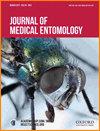Development of mixed linear models to analyze and describe the impact of malathion on the larval growth of Megaselia scalaris (Diptera: Phoridae) under various feeding media and environmental conditions
IF 2
3区 农林科学
Q1 ENTOMOLOGY
引用次数: 0
Abstract
Forensic entomology plays a crucial role in estimating the minimum postmortem interval through the study of insect larvae found at crime scenes. The precision of this estimation relies on various biotic and abiotic elements that simultaneously influence insect growth and development, encompassing factors such as temperature, humidity, photoperiod, diet, and the existence of xenobiotics in decomposing tissues. Despite numerous studies on the influence of these factors, including the impact of xenobiotics, there are currently no robust tools available for making corrections to this estimation considering concurrently all variables. In an attempt to propose an exploratory and descriptive statistical model to analyze the simultaneous effect and interaction of different variables on larval growth, this study aimed to compare the effect of malathion on the growth of Megaselia scalaris (Loew, 1866) (Diptera: Phoridae) raised in malathion-spiked porcine muscle, under controlled and uncontrolled temperature and humidity conditions (environmental conditions). Larvae were also reared using various growth media. A split-plot design that combined crossed and nested factors was employed; 2 linear mixed models were developed to assess the relationships between the variables. The model provides valuable insights into the complex interactions among xenobiotics, growth media, and environmental conditions in the size and development of M. scalaris.建立混合线性模型,分析和描述马拉硫磷在不同饲养介质和环境条件下对鳞翅目(Diptera: Phoridae)幼虫生长的影响
通过研究在犯罪现场发现的昆虫幼虫,法医昆虫学在估算死后最小间隔时间方面发挥着至关重要的作用。这种估计的精确性取决于同时影响昆虫生长和发育的各种生物和非生物因素,包括温度、湿度、光周期、饮食以及分解组织中是否存在异种生物等因素。尽管对这些因素的影响(包括异种生物的影响)进行了大量研究,但目前还没有可靠的工具来对同时考虑所有变量的估算进行修正。为了提出一种探索性和描述性统计模型来分析不同变量对幼虫生长的同时影响和相互作用,本研究旨在比较马拉硫磷在受控和非受控温度和湿度条件(环境条件)下对在添加马拉硫磷的猪肌肉中饲养的 Megaselia scalaris (Loew, 1866) (双翅目:萤火虫科)生长的影响。幼虫的饲养也使用了不同的生长介质。采用了结合交叉和嵌套因素的分割图设计;建立了两个线性混合模型来评估变量之间的关系。该模型为了解异种生物、生长介质和环境条件在鳞栉水母的体型和发育过程中的复杂相互作用提供了有价值的见解。
本文章由计算机程序翻译,如有差异,请以英文原文为准。
求助全文
约1分钟内获得全文
求助全文
来源期刊
CiteScore
4.60
自引率
14.30%
发文量
207
审稿时长
3-8 weeks
期刊介绍:
Journal of Medical Entomology is published bimonthly in January, March, May, July, September, and November. The journal publishes reports on all phases of medical entomology and medical acarology, including the systematics and biology of insects, acarines, and other arthropods of public health and veterinary significance. In addition to full-length research articles, the journal publishes Reviews, interpretive articles in a Forum section, Short Communications, and Letters to the Editor.

 求助内容:
求助内容: 应助结果提醒方式:
应助结果提醒方式:


